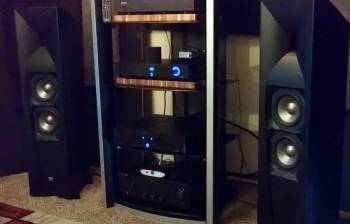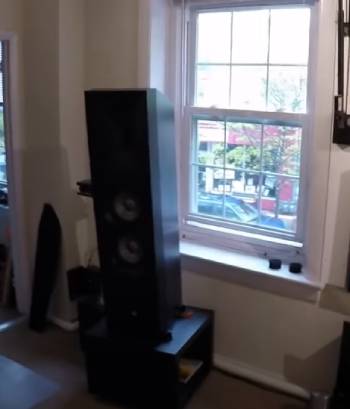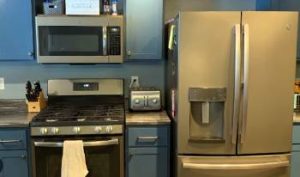In the world of high-quality sound systems, few names ring out as clearly as JBL. Their series of studio speakers are renowned for their impeccable sound quality and sleek design. Two of the heavyweights in this range, the JBL Studio 580 and the JBL Studio 590, have each earned their fair share of accolades.
Let’s dive deep into the characteristics of both models, weighing their pros and cons, to see which one emerges victorious in the battle of the JBL Studio 580 vs 590.
A Brief Comparison Table
| Feature | JBL Studio 580 | JBL Studio 590 |
| Size | Compact, ideal for smaller spaces | Larger, suitable for bigger spaces |
| Woofers | Dual 6.5-inch PolyPlas woofers | Dual 8-inch PolyPlas woofers |
| Bass Response | Limited low-end response | Impressive low-end response |
| Soundstage | Adequate for smaller spaces | Greater for larger rooms |
| Cost | More cost-effective | Pricier |
| Ideal For | Smaller spaces, tighter budgets | Larger spaces, deeper bass preference |
The JBL Studio 580: A Compact Powerhouse
Let’s kick off with the Studio 580. It’s the smaller of the two, but don’t let its size fool you. This speaker packs a serious punch.
Pros of the JBL Studio 580

- Compact Design
The Studio 580’s smaller size makes it ideal for more intimate spaces. It can fit comfortably on a bookshelf or desk without dominating the room.
- Powerful Sound
Despite its size, the Studio 580 delivers a robust sound that belies its compact design. The dual 6.5-inch PolyPlas woofers make sure of that.
- Cost-Effective
Priced lower than the 590, the Studio 580 is a more wallet-friendly option while still delivering premium sound quality.
Read More: About MEZE 109 Pro And Focal Clear Headphone
Cons of the JBL Studio 580
- Limited Low-End Response
While the Studio 580 does an admirable job across most frequencies, it can struggle to reproduce the very lowest bass notes.
- Less Suitable for Larger Spaces
The smaller size of the Studio 580 means it may not fill larger rooms as effectively as its bigger sibling, the 590.
The JBL Studio 590: Size and Sound in Harmony
Moving onto the Studio 590. This speaker is the bigger brother in the lineup, and it certainly lives up to that role.
Pros of the JBL Studio 590

- Impressive Low-End Response
Equipped with dual 8-inch PolyPlas woofers, the Studio 590 delivers a rich, resonant bass that the 580 struggles to match.
- Ideal for Larger Spaces
Thanks to its larger size and more powerful woofers, the Studio 590 is more capable of filling bigger rooms with sound.
- Greater Soundstage
The 590’s larger footprint lends itself to a broader soundstage, giving a greater sense of immersion when listening to music or watching films.
Cons of the JBL Studio 590
- Pricey
The Studio 590 comes with a heftier price tag than the 580, which may deter budget-conscious consumers.
- Space-Consuming
Its larger size means the Studio 590 demands more room, which could be a disadvantage in smaller spaces.
Read More: About Differences Between Mackie Thump Vs. EV ZLX
The Showdown: JBL Studio 580 vs 590
In the battle of the JBL Studio 580 and 590, the choice comes down to individual needs. The Studio 580 is a fantastic choice if you’re tight on space or budget but still crave quality sound. Meanwhile, the Studio 590, with its superior bass and larger soundstage, is perfect for those with a little more room and budget to play with.
Frequently Asked Questions (FAQs)
While both speakers provide excellent sound quality, the Studio 590 tends to deliver a more resonant bass and broader soundstage due to its larger size and dual 8-inch woofers.
Absolutely! Both the Studio 580 and 590 are well-suited for home theater setups. They deliver crisp, clear, and detailed sound, making your movie or music experience immersive.
Both speakers are built with quality materials designed to last. However, it’s always a good practice to handle your speakers carefully to extend their lifespan.
This primarily depends on your specific needs. If you have a larger space and a desire for deeper bass and a wider soundstage, the additional cost of the Studio 590 may well be justified.
Yes. Both the Studio 580 and 590 are passive speakers, meaning they require an external amplifier or receiver to function.
While both speakers deliver excellent sound quality, they are designed more for home use. For professional studio use, you may want to consider studio monitors designed specifically for that purpose.
Wrapping Up
In the end, the decision between the JBL Studio 580 and 590 comes down to your specific needs and preferences. If you’re looking for a compact and budget-friendly speaker that still delivers high-quality sound, the Studio 580 might be your pick. But if you have a larger space and crave a deeper bass and wider soundstage, and don’t mind shelling out a bit more, the Studio 590 could be your winner.
Regardless of your choice, with the JBL Studio series, you’re stepping into a realm of superior sound quality that will transform your listening experience. So, whether it’s the 580 or the 590, you’re in for a treat. Happy listening!



